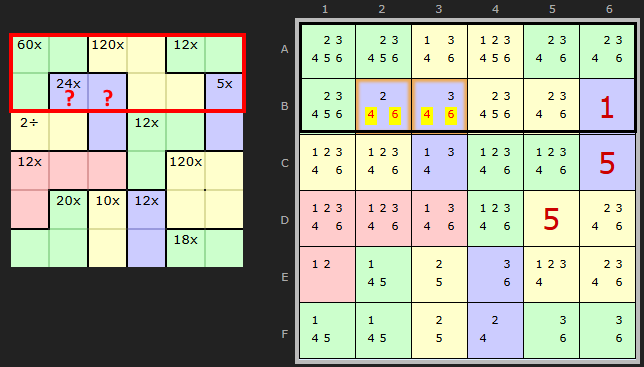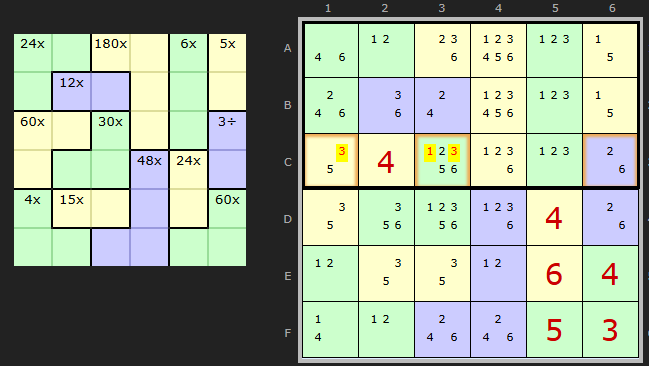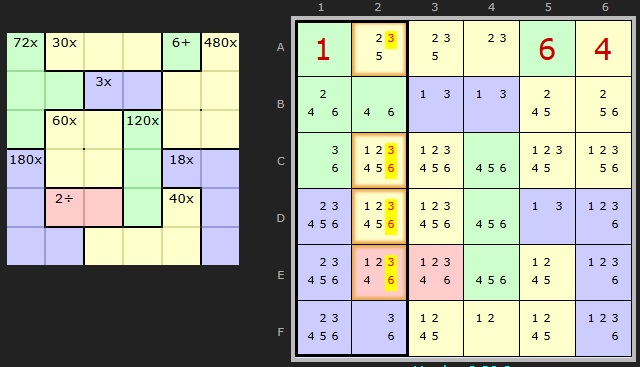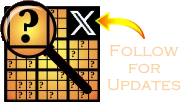Rule of 720
by Roger Taft
The Rule of 720 is based on multiplication in the same way that the Rule of 21 is based on addition. Each row or column in a 6x6 KenKen sums to 21 and multiplies to 720. A block of two rows or columns sums to 21+21 = 42 and multiplies to 720*720. And so on for up to a block of six rows or columns, the whole puzzle.
First, a bit of terminology. For brevity the Rule of 720 strategy is referred to as R720. A block is a set of adjacent rows or columns. A cage, or partial cage of cells within a cage, is called a unit.
A block is filled with units of known products and units of unknown products. R720 computes the product of the known units then divides it into the block size product to find the target product for the unknown units. Details of the unknown units can then be deduced. The more clues there are that are multiplication, the more likely R720 will help. In some cases R720 is required to solve the puzzle.
In simple terms: If you can find some rows or columns with mostly x multiplication cages, few innies and outies, and one non-multiplication, we can predict the SUM (+ clue) of what the cage will be. This reduces the combinations and makes eliminations.
Known units come in several forms:- All cages with the multiply operator are known units. The known product is the value of the clue. For example, a cage with the clue 24x has a known product of 24.
- All cells with known values have a known product, namely the value of the cell. For example, a cell known to be a 5 has the product of 5. As the solution advances there are more known cells.
- All units that are locked sets have the product that is the product of the locked set cells. All pairs and triples have known products.
- Other common locked sets with their known products are:
Some non-multiplication cages are also helpful
| Clue | Cells | Locked Set | Known Product |
| 3+ | 2 | {1,2} | 2 |
| 4+ | 2 | {1,3} | 3 |
| 6+ | 3 | {1,2,3} | 6 |
| 5- | 2 | {1,6} | 6 |
| 10+ | 2 | {4,6} | 24 |
| 11+ | 2 | {5,6} | 30 |
| 14+ | 3, | linear{3,5,6} | 90 |
| 15+ | 3, | linear{4,5,6} | 120 |
Some clues show up often as unknown units. Here are some along with their products:
| Clue | Solution | Product |
| 3/ | {1,3} | 3 |
| {2,6} | 12 | |
| 2/ | {1,2} | 2 |
| {2,4} | 8 | |
| {3,6} | 18 | |
| 1- | {1,2} | 2 |
| {2,3} | 6 | |
| {3,4} | 12 | |
| {4,5} | 20 | |
| {5,6} | 30 |
Example 1

In this first example there is a block of 2 rows, boxed in red, consisting of 4 cages. Three of the cages have a multiplication clue, so have a known value. The fourth cage E45 has a division clue of 2/. The value of this cage is unknown. Using R720 the
product signature of the unknown 2÷ cage will be:
(720*720) / (24*48*25) = 18
There are three possible solutions for a 2÷ cage as enumerated above. A product signature of 18
means the solution is {3,6}.
Example 2

Here we show that the one cage only partly in the block is the one 'unknown' product - for the two cells B23 inside the block. Knowing the cage is 24x doesn't help at all. We can ignore the cage starting in B6 because we have the solution there. And since it is 1, it has no effect.
Conveniently the clues for the cages (60x, 120x and 12x) are all factors of 720. This is helpful, since instead of the formula
(((720 * 720) / 60) / 120) / 12
we can re-express it as
(720 / 60) * (720 / 120) / 12
or 12 * 6 / 12 = 6
So B23 must be 2 and 3 (2x3=6)
Example 3

Here is a slightly more sophisticated version covering three rows. We have three single innies from three cages. However all the cages wholly inside are multiplication
((((((720 * 720 * 720) / 24) / 180) / 6) / 5) / 12 / 4
But 720 cubed is a very large number!
And when there are four rows or columns in a block it is gigantic — 7204.
Let us re-write that as
(720 / 24) * (720 / 180) * (720 / 12) / 6 / 5 / 4
or
(30 * 4 * 60) / 6 / 5 / 4 = 60
So 60 must occupy three cells C1, C3 and C6. The only combination for that is 2 x 5 x 6.
Example 4

In the block of columns 1 and 2, shown in red, the product signature is 720*720. The block contains Cage A1(72x)=72 and Cage D1(180x)=180. The remaining four cells, all unknown, show in blue, have a product signature of
(720*720) / (72*180) = 40
Neither 3 nor 6 divides 40 evenly so all 3s and 6s in the unknown cells can be eliminated. This type of candidate elimination is common with R720.
The earliest reference to a Rule of 720 strategy found is in a 2009 Dell Magazines paper on KenKen Solving Tips. In 2010 Tom Davis mentions the topic in KenKen for Teachers". There are scattered references to it in online forums over the years

Comments
Email addresses are never displayed, but they are required to confirm your comments. When you enter your name and email address, you'll be sent a link to confirm your comment. Line breaks and paragraphs are automatically converted - no need to use <p> or <br> tags.